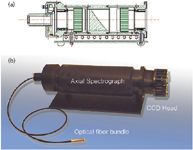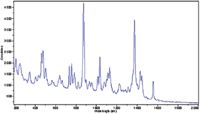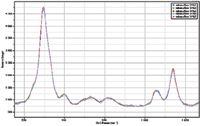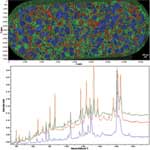Transmission Raman Offers Improved Quantitation of Pharmaceutical Solids
Special Issues
Manufacturing control of pharmaceutical solids requires routine measurement of content uniformity. Because of the high information content in Raman spectra, it has been considered a candidate technology for making these measurements.
Because the information content of vibrational spectroscopy is so high, Raman is being exploited for measurement of content uniformity of pharmaceutical tablets. Unlike infrared absorption, Raman is not subject to artifacts due to light scattering and particle size. However, the probed volume tends to be small, making bulk measurements challenging. In order to acquire spectra that represent the average content of a pharmaceutical tablet, optical methods for recording transmission Raman spectra are being developed and will be described here.
Manufacturing control of pharmaceutical solids requires routine measurement of content uniformity. Because of the high information content in Raman spectra, it has been considered a candidate technology for making these measurements.
However, the typical Raman sampling volume, which is determined by the laser diffraction limit, is usually relatively small (<100 μm). Consequently, the accuracy of a quantitative bulk measurement will be questionable because the particle sizes are comparable to the sampling volume, and the sample itself is inhomogeneous. While microscopic sampling has greatly simplified the sampling complexity for the user, it makes this situation even more problematic because the probe spot size can approach 200 nm (0.2 μm), leading to significant subsampling.
There are ways to combine the advantages of microscope sampling with low spatial resolution required for bulk measurements. One method is to scan the sample in the laser beam during the measurement. Another involves the use of a low magnification objective. Such an objective, however, will have a low numerical aperture (NA), so the light gathering power will also be reduced, which will lower the sensitivity.
In addition, the spot size will still be no larger than 50–100 μm, which is still too small for macroscopic composition measurements. But, in spite of this, fast mapping has shown that it is possible to collect images of entire tablets (about 10 mm in diameter) in times as short as 5 min. But the remaining problem with this solution is that the measurement is really only probing the surface of the tablet. If there is any type of thick layering in composition, that layering may be totally missed. It is for this reason that transmission Raman has been developed for pharmaceutical solids — by collecting light on the far side of the tablet, collected photons will have seen the entire thickness of the tablet.
Transmission Raman Implementation for Pharmaceutical Solids
The concept of transmission Raman is to relax the precise focusing conditions that are usually imposed on Raman optics in order to optimize signal generation and collection. On a microscope the laser is focused on the sample to a diffraction-limited spot, and the back-scattered light is collected by the same optic and precisely magnified and imaged onto the spectrograph entrance slit and then the detector. Such a scheme optimizes the collection efficiency through the entrance slit for microscope sampling without compromising spectral resolution. By the very nature of a transmission geometry through a turbid sample, it will not be possible to collect and focus onto a narrow spectrograph entrance slit all of the Raman photons generated by a laser beam passing through such a material. The initial experiments were done by compromising the collection efficiency to gain access to the bulk, subsurface material, but in more recent implementations, much of the light collection is recovered with the use of fiber-optic bundles.
The concept of transmission Raman for pharmaceutical solids evolved out of work at the Central Laser Facility of the Rutherford Appleton Laboratory (1). This scheme, in turn, evolved out of earlier work on spatially offset Raman spectroscopy (SORS), which itself evolved out of their time-resolved, photon-migration studies in fluorescent–turbid media (2,3).
Today the measurement is done by focusing the laser beam to a rather large spot on one side of a tablet and then utilizing a fiber bundle to collect the light that is transmitted by the tablet. Because the light passes through the entire tablet, the tendency to weight the signal from the surface material is avoided.
This scheme with fiber optics was first described by the AstraZeneca group (4), and is shown in Figure 1. The laser spot on the sample is on the order of the size of the tablet. The light that exits the far side of the sample contains both the laser wavelength and the Raman light. A filter (not shown) removes the laser wavelength and a bundle of fibers collects the Raman light; the collection fibers are rearranged to a line at the exit end, enabling highly effective optical matching with the spectrometer entrance slit; the loss of light that was cited earlier due to the particle light scattering is partially recovered by the multiple fibers.

Figure 1: Schematic of transmission Raman on a pharmaceutical tablet.
A simplified implementation of transmission Raman is shown in Figure 2. Figure 2a shows the tablet mounted for illumination from below, with the fiber bundle above mounted to collect the Raman signal. Figure 2b is a photograph of the tablet being illuminated by a red laser. Note that because of the light scattering the entire tablet is lit up by the laser light. That means that the Raman signal that is collected from above will reflect material from the large illumination volume. (In this case the beam spot was 4.2 mm, but can be optically adjusted to other dimensions.)

Figure 2: Photographs of (a) a pharmaceutical tablet mounted for transmission illumination from below (shown as a green laser), with the Raman signal to be collected from above by the fiber bundle, and (b) a pharmaceutical tablet being illuminated by a red laser.
To optimize the spectral acquisition for this type of application, a specially designed axial spectrograph has been designed based on a "grism." A grism is a prism on which a grating is deposited, enabling dispersion in the forward direction. Figure 3a shows the optical schematic of the grism spectrograph. The grism itself is in the center of the cylinder. Figure 3b is a photograph of the grism spectrograph with a fiber bundle mounted at the input. In the case of transmission Raman, the fiber bundle contains 61 fibers arranged in a circle to collect the Raman signal, and then the fibers are arranged in a line for input to the spectrograph.

Figure 3: (a) Optical schematic of the grism spectrograph. The light is delivered on the left from a series of 61 50-μm fibers, collimated by a near-IR achromat, dispersed by the prism, then dispersed by the grating deposited on the prism, and finally focused on the CCD camera on the right. (b) Photograph of the grism (axial) spectrograph showing the fiber bundle input on the left and the CCD camera on the right.
Transmission Raman Results
The litmus test for the usefulness of this design is the quality of the spectrum that can be collected in a "reasonable" amount of time. Figure 4 shows a spectrum of a tablet recorded in 20 s on the axial spectrograph designed to capture a Raman signal excited at 785 nm.

Figure 4: Transmission Raman spectrum of compressed tablet recorded with 785-nm laser, 170 mW at the sample, 2 Ã10 s acquisition, about 2100 cmâ1 coverage on the axial spectrograph (650 g/mm grating).
The signal-to-noise ratio is quite acceptable for quantitative work. However, the true strength of this technique is demonstrated by the reproducibility of this measurement. Because the measurement scheme is designed to average the composition over a large volume, it yields much better reproducibility than conventional Raman measurements. Figure 5 shows the spectrum in the region between 830 and 1070 cm–1, recorded five times, each time manually removing and replacing the tablet on the platform. The variations from measurement to measurement are observed to be quite small.

Figure 5: Tablet spectrum recorded five times in the transmission Raman apparatus, removing and replacing the tablet before each measurement. The variations between measurements are almost not observable.
For comparison, Figure 6 shows the results of a tablet map. The map in Figure 6a was acquired on a Horiba LabRAM HR microscope instrument using a 532-nm laser, a 10× objective, and a 600 g/mm grating. The map covered an area of 17 × 7 mm2, with 50 μm per point in the map (341 × 141 points). Each data point was acquired in 1 ms using the instrument's SWIFT (Scanning With Incredible Fast Times) feature. This tablet map is a visual image of the tablet's composition that enables the quantification of the various components as well as their distribution. But if the average composition of the API in the tablet is required, any one spectrum extracted from any one point in this map will not be a reliable indicator. Figure 6b shows representative spectra of various locations on the sample; their variability indicates the degree of heterogeneity of the sample. In fact, it is precisely this heterogeneity that is of interest when mapping. But comparison of Figure 6b to Figure 5 shows how valuable transmission Raman will become just because it can report the average of the entire tablet effectively and reproducibly.

Figure 6: (a) Tablet map: 17 Ã7 mm2, acquired with 314 Ã141 points (50 μm/point) on a LabRAM HR system, equipped with a 532-nm laser, a 600 g/mm grating, and a 10Ãobjective. (b) Five spectra extracted from the tablet map of Figure 6a. Each spectrum represents the average over a 500-μm square and illustrates the variability of the signal due to the heterogeneity of the sample.
One can argue that once a map is acquired, the mean spectrum of the entire map can be calculated. However, it should be pointed out that if the information in the map is not required, the cost for this measurement is not warranted. On the other hand, there is a case where only a map can achieve the composition information on a tablet. There are cases where the active pharmaceutical ingredient (API) composition is quite low, and observing it in a transmission measurement may be difficult because of "spectral dilution." In such cases a map can be successful in documenting the presence and quantity of the API because the spectrum at each point is more likely to be pure, or at least have a high concentration for each of a small number of components. In fact, this capability can be useful in detecting any species present at low concentrations, such as Mg stearate.
Conclusions
For QC transmission Raman measurements of tablets, there must be a robotic type of sample exchange on which multiple samples can be placed for automated measurements. The sample mount can take the form of a carousel or a rectangular matrix or any other format appropriate for a particular sample type.
Software capabilities that include quantitation based on peak integration, or any of the multivariate calculations, can then provide information on the samples' composition. Raman measurements can now be said to be truly quantitative and reliable for product development and manufacturing quality control.
Fran Adar, Eunah Lee, and Andrew Whitley are with Horiba Jobin Yvon, Edison, New Jersey.
References
(1) C. Elliasson, M. Claybourn, and P. Matousek, Appl. Spectrosc. 61(10), 1123–1127 (2007).
(2) P. Matousek, N. Everall, M. Towrie, and A.W. Parker, Appl. Spectrosc. 59(2), 200–205 (2005).
(3) N.A. Macleod and P. Matousek, Appl. Spectrosc. 62(11), 291A–304A (2008).
(4) J. Johansson, A. Sparen, O. Svensson, S. Folestad, and M. Claybourn, Appl. Spectrosc. 61(11), 1211–1218 (2007).

AI-Powered SERS Spectroscopy Breakthrough Boosts Safety of Medicinal Food Products
April 16th 2025A new deep learning-enhanced spectroscopic platform—SERSome—developed by researchers in China and Finland, identifies medicinal and edible homologs (MEHs) with 98% accuracy. This innovation could revolutionize safety and quality control in the growing MEH market.
New Raman Spectroscopy Method Enhances Real-Time Monitoring Across Fermentation Processes
April 15th 2025Researchers at Delft University of Technology have developed a novel method using single compound spectra to enhance the transferability and accuracy of Raman spectroscopy models for real-time fermentation monitoring.
Nanometer-Scale Studies Using Tip Enhanced Raman Spectroscopy
February 8th 2013Volker Deckert, the winner of the 2013 Charles Mann Award, is advancing the use of tip enhanced Raman spectroscopy (TERS) to push the lateral resolution of vibrational spectroscopy well below the Abbe limit, to achieve single-molecule sensitivity. Because the tip can be moved with sub-nanometer precision, structural information with unmatched spatial resolution can be achieved without the need of specific labels.